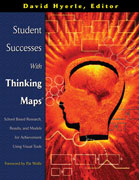



 dent Successes With Thinking Maps®
dent Successes With Thinking Maps®David Hyerle, editor with Sarah Curtis and Larry Alper co-editors
Chapter 4: Tools for Integrating Theories and Differentiating Practice
Alan Cooper, B.Ed.
Given the short description above of the intersection of emotional and interpersonal intelligences, global and analytic learning styles, and habits of mind, we may begin to see how thinking maps provide a unique, unifying language across these four approaches, each of which is theoretically rich. The thinking maps provide the “how to” tools that may be both linear and nonlinear, as well as detailed and holistic. Importantly, they are problem-solving tools used for executive processes (see Chapter 3: “Leveling The Playing Field for All Students”), not just information processors, and in the situation investigated above, the teacher was in the background having created the learning environment. Harry and Douglas did their work and problem solving, in this case with only the one flow map as the immediate, mediating agent. By their very nature, thinking maps are not content or task bound. They are adaptable and can be easily customized to suit individual learning styles and interdisciplinary problems.
Read the complete chapter in the book Student Successes With Thinking Maps. Key sections from the chapter Tools for Integrating Theories and Differentiating Practice with excerpts above include:
- Integrating Tools for Differention
- Theories into Practice
- Linking to Emotional Intelligence
- Linking to Multiple Intelligences
- Linking Learning Styles
- Linking Habits of Mind
- Thinking Maps: A Unifying Set of Tools
- Reflections: Emergent Thinkers, Life-long Learners
Alan Cooper, B.A., B.Ed. Dip Tchg. ANZIM is a New Zealand independent consultant specializing in thinking skills and how learning occurs. As Headmaster of St. George’s School for 17 years, he was known for taking responsible risks in educational innovation, including the first implementations of Thinking Maps and the Dunn and Dunn Learning Styles models in New Zealand.
![]() Click here (pdf file) to download Research Highlights from
Click here (pdf file) to download Research Highlights from
Student Successes With Thinking Maps
For more on Student Successes With Thinking Maps go to the following links: